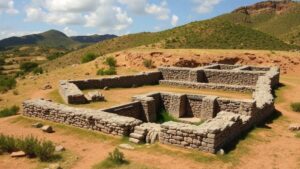Exploring the Loch Ness for advanced sonar evidence of Nessie, the legendary aquatic cryptid.
Exploring the Loch Ness for Advanced Sonar Evidence of Nessie
The haunting waters of Loch Ness, located in the Scottish Highlands, have been the source of fascination and speculation for centuries. This vast freshwater lake, stretching about 23 miles, is not just famous for its stunning picturesque views but also for the enigmatic creature it purportedly harbors: the Loch Ness Monster, affectionately known as Nessie. In recent years, advanced sonar technology has emerged as a promising tool for researchers aiming to uncover the truth behind this legendary aquatic cryptid. This article explores the methods, findings, and implications of utilizing sonar in the search for Nessie.
The History of Nessie
The fascination with Loch Ness dates back to ancient times. first recorded sighting of a creature resembling Nessie occurred in a 565 AD account written by St. Columba, an Irish monk. He claimed to have encountered a water beast that threatened one of his followers. Over the centuries, various sightings and testimonies have continued to fuel curiosity, leading to a burgeoning folklore surrounding the creature.
In the 1930s, the publication of a famous photograph known as the Surgeons Photograph further captured public interest, leading to a flurry of research and speculation. But, many supposed sightings were debunked over time, leading to skepticism regarding Nessie’s existence. Nonetheless, the remaining intrigue has kept Loch Ness in the spotlight.
Advancements in Sonar Technology
The field of sonar technology has made remarkable strides over the past few decades, evolving from rudimentary methods to sophisticated systems capable of producing high-resolution images of underwater landscapes. Sonar, which stands for Sound Navigation and Ranging, uses sound waves to detect and locate objects under the water. Researchers have been employing two main types of sonar in their investigations:
- Side-scan sonar: This technology creates detailed images of the seabed and submerged objects by emitting sound waves from a towed or mounted device. It is notably effective in identifying unusual shapes and anomalies.
- Multibeam sonar: This advanced system maps the seafloor by sending out multiple sound beams, allowing for comprehensive topographical mapping of the underwater environment.
Recent Research Expeditions
In 2018, a groundbreaking effort dubbed Project Nessie was initiated, utilizing both side-scan and multibeam sonar technologies. A team of scientists embarked on a detailed exploration of Loch Ness with cutting-edge equipment designed to locate potential underwater signatures indicative of large marine creatures. This project marked a significant shift in the approach to finding Nessie, transitioning from anecdotal evidence and eyewitness accounts to scientific investigation.
The expeditions garnered international attention and attracted enthusiasts from around the globe. Using sonar technology, the team scanned continuous areas of the lake, collecting vast amounts of data. While ultimately, no definitive evidence of Nessie was found, the data produced valuable information about the aquatic ecosystem of Loch Ness, uncovering various fish species and underwater features that had not previously been documented.
Challenges in the Search for Nessie
While the use of sonar presents an exciting avenue for exploration, it is not without its challenges. The vastness of Loch Ness, coupled with its depth–reaching approximately 755 feet–makes exhaustive scanning a daunting task. Plus, the murky waters can limit visibility and affect sonar readings. Environmental factors, including underwater plant growth and geological formations, may also generate false positives, leading to misinterpretations of sonar data.
Real-World Applications and Implications
The exploration of Loch Ness for Nessie has broader implications beyond mere curiosity. Various sonar technologies are already utilized in diverse fields, such as:
- Marine biology: Understanding aquatic ecosystems and tracking marine life populations.
- Environmental monitoring: Mapping underwater habitats and assessing the impacts of climate change on aquatic environments.
- Search and rescue operations: Locating submerged objects and individuals in emergencies, demonstrating real-life applications of sonar technology.
As researchers continue to harness advanced sonar technologies in Loch Ness, the findings may not only bring clarity to the legend of Nessie but may also contribute to our understanding of the lakes biodiversity and environmental health.
Conclusion and Actionable Takeaways
The quest for Nessie encapsulates humanity’s enduring fascination with the unknown. While advanced sonar technologies have yet to provide definitive evidence of the Loch Ness Monster, they have transformed the methodologies scientists utilize to study such phenomena. As further expeditions are planned and technology continues to advance, the search for Nessie remains a thrilling endeavor that marries science with mythology.
For those interested in following this journey or participating in future endeavors, staying informed about ongoing research initiatives and advancements in sonar technology is vital. Whether as an observer or a contributor, engaging with the mysteries of Loch Ness will undoubtedly yield fascinating discoveries.

